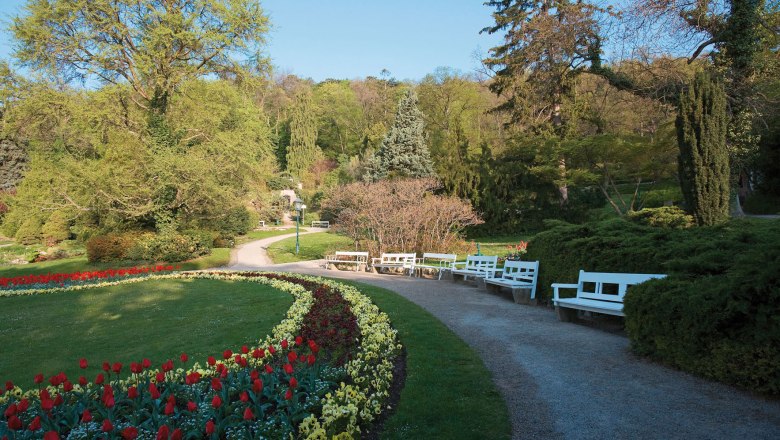Historical Kurpark
52 hectares in area and rich in history
52 hectares is the size of the Baden Kurpark and thus one of the largest spa parks in Europe. In addition to beautiful scenery, peace and relaxation, the spa gardens offer numerous historical attractions.
A Beethoven temple, the music pavilion where short concerts are held in summer, several monuments to performers, writers and the emperor, the Undine fountain and a nostalgic park café. The garden is home to a variety of subtropical plants and captivates with its decorative floral ornaments.
At the Kalvarienberg, the Kurpark merges smoothly into the black pine forests of the Vienna Woods with their many hiking trails.
Kurpark
Kaiser Franz - Ring
The Theresienbad used to occupy a part of the area now taken up by the new Congress Casino. The small Theresien garden extended to the front of this bath, which became the Stadtpark and later the Kurpark. At that time, this park extended in the east to approximately today's Park-Café and the Undine Fountain, in the north to the main steps, and was bordered in the west by the no longer existing Theresien and Ursprungs (original) baths. Under Mayor Franz Maynolo (1785-1795), at the instigation of Stadtsyndikus, Johann Georg Grundgeyer (1733-1805) – from 1762 he held this office, which is roughly similar to that of today’s city director – the gardener Jean Baptist Barbé was able to be transferred over by the Vöslau rulers.
The park was completely open on the city side and only in 1880 did it receive its present representative railings. This small, modest park, the ‘germinal cell’ of today's magnificent Kurpark, became world famous in the Biedermeier era. Until 1868 the park was illuminated with oil lamps, then gas lighting and at the end of the century after 1894, in addition to the gas mantle lamps, electrification was introduced, which only became established in 1925-1932. The hills and today's Kalvarienberg (Calvary hill)- this name has been given to it since the city judge Michael Schlachtner had stations of the cross built in the years 1690-1700 - were a sandy limestone desert, strewn with rock debris and with an abundance of underground cavities. At the time, it was considered impossible to replant this landscape. After two unsuccessful attempts (in the years 1807-1812 and in the middle of the last century), the third attempt was successful. The town gardener Josef Schaffhausen carried out extensive reforestation in the years 1874-1896 with the help of the Baden Beautification Association. By 1932, his successor Josef Krupka had transformed it into an elegant park, which was enlarged in 1925 to include the part of the Beethoven Temple. In 1894 the music pavilion and the Park-Café, which is still in use today, were built. On 1 July 1903, the Undine Fountain was put into operation for the opening of the water pipeline, which had been in operation since 1902. Numerous monuments embellish the park, such as the Beethoven Temple (1926/28), the Grillparzer Monument (1899), the Kaiser-Josef Monument (1899), the Lanner and Strauß Monument (1912), the Floral Clock (1928/29), to name but a few.
The Kurpark can be visited all year round with free admission.
(no opening hours)
Entrance Kaiser Franz Ring
A - 2500 Baden bei Wien
